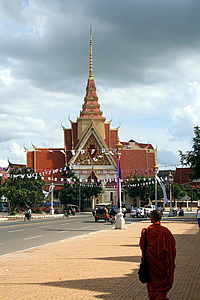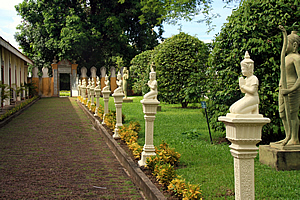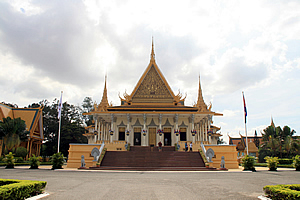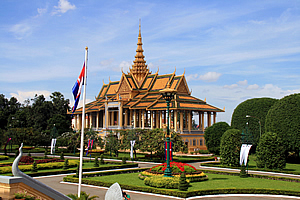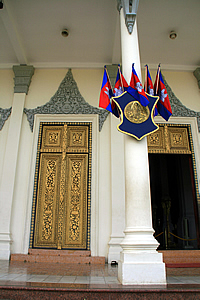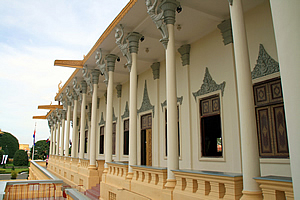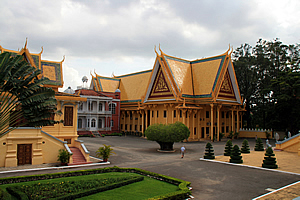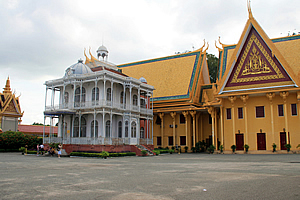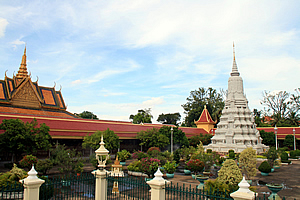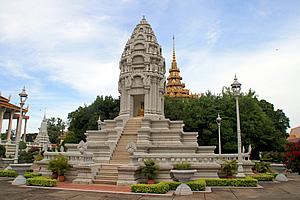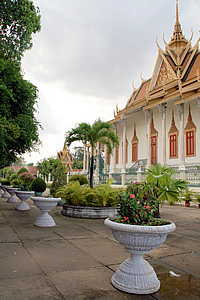--- Archive files ---
Home > Travels > Phnom Penh > 7 |
The Royal Palace
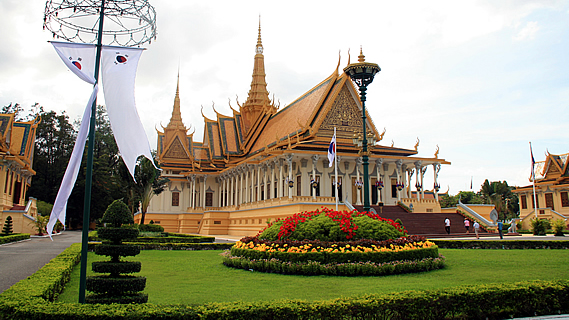
CAMBODIA is widely known for being one of the poorest countries in the world, with the average wage being about a dollar a day. Not everyone here is poor though. In fact some people here are extremely wealthy even by Western standards. The wealthiest person of them all was the man whose photo had been cut from the photo in the gallery of prisoners at Tuol Sleng – the school tuned into a genocide centre that we had visited this morning. This man was Norodom Sihamoni, who had escaped to settle in France to work as a ballet dancer. Eventually though he did return somewhat reluctantly upon his father’s death in 2004 to become the current king of Cambodia.
Monk and Palacial Building |
I walked around the park towards the white walls of the palace, passing the juxtaposition between the calmness of numerous Buddhist monks ambling along the cobbled path and the frenetic activity of the four wheel drives, tuk tuks and motorbikes. A building was built into the wall. Most of this building was white, but all the trimmings were gold plated like the Buddhist temples I had so far seen here in Cambodia. I continued walking along the path until I found myself at the back of a small queue at the entrance. The gates were due to open to the public very shortly, so I waited in the blistering heat. No one else in my tour group was anywhere to be seen, so I assumed they were all at the pub again. Typical Australians.
The gates opened and the queue started to progress into the palatial grounds. Instantly I was whisked away from the destitution outside to the opulent institutionalism of Cambodian royalty. We passed a row of small white statues as we approached the rather humble ticket booth. There I bought my ticket for a few dollars – about a week’s wage for the average Cambodian.
Statues lined up inside the entrance to the palace |
With ticket in hand, I continued walking along the narrow area between a building and the wall. To the right stood a long straight row of little white marble statues of kneeling Buddhas on tall pedestals spaced about two metres apart. I walked along it for about thirty metres before reaching a doorway sized entrance to a large courtyard.
The view from here was amazing. For the first time I could now see the throne hall – the centrepiece of the royal palace. I had seen the top of it from behind the wall previously, but now it had been revealed in its entirety. The throne hall had the same style as the Buddhist temples I had so far seen with white and deep cream walls with gold plating on the elephant trunk flourishes. The difference with this building was that it was colossal. The entire palace was set on a high stone dais with stairs going up to it. There were numerous other royal buildings around the palace. I quickly forgot the destitution of the Cambodia I had seen up till now as I stood in awe of this place.
The Royal Palace |
The throne hall was built in 1917, occupying the exact same site and orientation as the citadel Banteay Kev (The Crystal Citadel) which also faced eastward towards the river. The temple was built in 1813, but was burnt down in 1834 when the retreating Siamese army was at the time razing Phnom Penh. In 1863 the capital was moved from Oudong (about twenty kilometres away) into Phnom Penh. A temporary wooden throne hall was constructed in 1869 and demolished in 1915 to make way for the construction of the new one.
The throne hall was built in traditional Khmer architecture, but it incorporated some French colonial elements. The throne hall is only used now for religious ceremonies, coronations, royal weddings, and meetings with foreign heads of state.
Pagoda |
The Cambodian king is considered to be the way to Buddha, acting as the most high Buddhist priest. He is to the Cambodian Buddhists the Pope is to Catholics. This explained why the entire palace felt so deeply steeped in religion.
Numerous smaller buildings surrounded the central palace, each no doubt having a different political, religious or perhaps residential function. Some were gifted by foreign dignitaries including Napoleon Bonaparte. The age of the buildings ranged from the fourteenth century and the 1960s. The building to the right of the throne hall was the Khemarin Palace - the king’s residence and ministerial meeting areas. I’m sure this was the most opulent palatial area in the world – I had never before seen anything that even remotely comes close to this. Then again I haven’t seen much of the world, so perhaps there are even wealthier looking places than this.
Entrances to the Royal Palace |
Surrounding the buildings were elaborate gardens of perfectly manicured flower beds, shrubs and hedges. I walked along the paved sections crossing the Moonlight Pavilion (the open air pavilion area that served as the stage for Khmer classical dance performances) towards the palace and climbed up the stairs polished pink granite stairs towards the huge carved gold plated doors. Shoes had to be removed before entering the throne room.
Unfortunately photography of the inside was not allowed, but the interior was unlike anything I had ever seen before. Three huge chandeliers hung from the high cathedral ceiling – I had never seen chandeliers so magnificent before. Each one would make the large crystal chandelier in my lounge look like a cheap plastic LED bulb in comparison. These chandeliers were each the size of my entire lounge, each weighing a good tonne. The fifteen metre long cables holding them to the intricately frescoed ceiling must have a fair bit of tension in them. The walls and ceiling of the throne room were ornately decorated with the most amazingly detailed Buddhist frescoes (known locally as the Reamker) of dark red silk and gold plating.
Side of the Royal Palace |
The throne room had a long aisle running down the middle with seating on either side of it. At the back of the room were two huge golden thrones. Reach Balaing was in front and Preah Tineang Bossobok sat higher at the back. The amount of gold used to build this place must have been phenomenal.
After looking inside, I returned outside the palace to have a look around at the exterior décor. The roof was held up by huge cylindrical columns each with a grey life sized human (or perhaps angelic) figure positioned to look like it was holding up the roof. Perhaps they wanted the building to be living, still being in touch with the natural world even though being so far cut off from the forests and paddy fields of the real Cambodia.
Buildings around the royal palace |
I left the palace and walked towards the right, but a guard in a black and golden uniform quickly ushered me and other tourists to explore only the left buildings. Rumour had it that the president of South Korea was coming and this area had to be cleared of all the foreign riff raff. As I walked back past the palace I noticed the huge doors to the throne room closing shut. The palace had only been open for about ten minutes and I had been very lucky to have seen inside it, even with photography being banned.
Buildings around the royal palace |
I continued to the left and walked between some golden yellow buildings with few windows in them. Maybe they were storage sheds, but even these had the double layer elephant flourishes on them. In amongst the golden yellow buildings was a small two storey colonial house painted white which seemed to be a residence. It was a perfect cube shape with verandas going around each level and the elephant finials at the top giving the only indication that it fitted in. The Cambodian Khmer roof seemed out of place in this otherwise quaint colonial house. Maybe it had been a gift from a Western nation, probably France.
Bonsai Garden |
I passed in between numerous temples all closed off with their entrance doors locked. I entered a large courtyard containing a myriad of bonsai trees all aligned in a regular array. The trees here were of all sorts of shapes and sizes. There were shrubby broadleaf trees, tall palms, small plants and manicured trees with perfect topiary. Here there were specimens of every imaginable shaped shrub laid out in a complete randomness of disorder though not at all cluttered.
Temple |
Once past the bonsai garden, I entered another area containing more temples. There were small altars outside, and one huge grey bell shape tower in the middle. The buildings here had interesting names like the Silver Pagoda and the Temple of the Emerald Buddha. Both were very significant. The temple of the emerald Buddha once housed the most revered Buddhist artefact – a Buddha statue made of a single piece of carved jade. The emerald Buddha was now in Thailand, but this temple remained. No doubt each of the other buildings here represented something significant uniquely distinguishing itself from all the other temples here.
Potted bonsai |
I finally reached a small hill covered in thick bush including golden cane palms. Several sitting Buddhas sat around the hill facing outwards as if to provide protection for anyone who ventured there. Each was wearing a pastel yellow cloak. A stairway meandered up the hill with the entrance guarded by a griffin statue. I climbed the stairway to the top, but there was little up the hill – just a rather empty tiny courtyard surrounded by vegetation that I thought was perhaps overdue for pruning. Perhaps this was just a quiet retreat for the king to collect his thoughts away from the rigors of his royal duties.
Two more grey temples stood at the base of the hill. One had a top identical to what I was expecting in the towers of Angkor Wat – the distinctive lotus bud shapes. The other was a pointed cone shape with numerous patterned layers. Each was elaborately carved from marble and had a perfectly manicured garden around the outside. I then entered an open hall with numerous black Buddha sculptures at the back.
Across the courtyard was what appeared to be an outdoor museum with numerous small temples, statues, and trailers all seemingly random in layout. Then I entered a building containing some amazing chandeliers. These were nothing compared to the ones in the throne room, but they were pretty amazing nonetheless.
Once through the building, I was at the exit. I left the excessive opulence of the palace and returned back to the hustle and bustle of the real Cambodia concealed outside its immaculate white walls.
<< Previous | Next >> |
|
||
About this Page
|
||
|
|
|
Where is Walkabout Jeff? |
|
|
|
|
What is happening in Walkabout Jeff's hometown?
|
|
|
|
|
Who is Walkabout Jeff?Any normal person's idea of going out involves going to the local pub for a drink with a few mates. Walkabout Jeff isn't normal.
|
|
|
|
|
